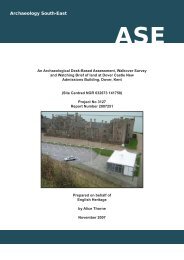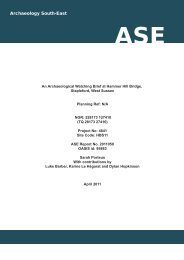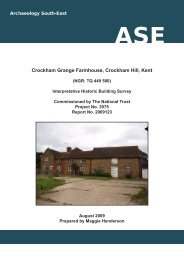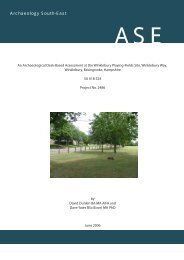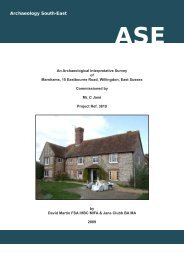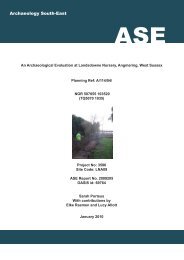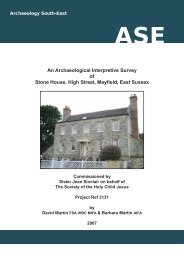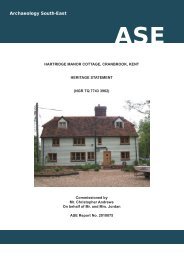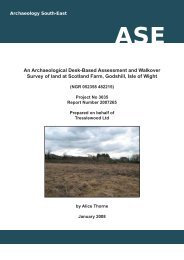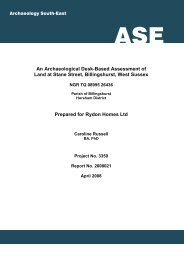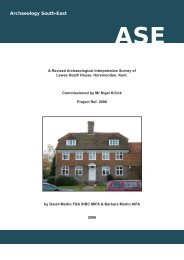<strong>Archaeology</strong> <strong>South</strong>-<strong>East</strong>2008058: Holbury Infants School, Holbury, Hampshire2.0 ARCHAEOLOGICAL BACKGROUND2.1 The proposed development is located within the grounds of CadlandsPrimary School, formerly Holbury Infants School in Holbury, <strong>South</strong>ampton,within an archaeologically sensitive area.2.2 Holbury Manor lies c.500m to the northwest of the site and a Medievalsettlement is recorded to the south of the site at Rollestone Farm which wasfirst documented in 1331 as Rolveston (Hrothaulf’s Farm) (SMR ReferenceSU40SW 70; Figure 1, Point 1).2.3 The earliest record of Holbury Manor dates to 1312 when the land wasgranted to the abbots of Beaulieu and documentary sources suggest that aformer ‘grange’ existed on the site. The manor remained under monasticcontrol until the Dissolution. In 1542 Henry VIII exchanged Holbury withRobert Whyte for a manor estate in Middlesex. Following which Holbury islast mentioned as a whole manor when Nicholas Pescod granted a lease ofthe estate to Adam de Cardonell, subsequently it was divided, with one halfbeing passed to Lady Mary Talbot and later to the Hon. Robert Drummond aspart of the Cadlands Estate in 1772. From 1693 the other half was owned byWilliam Stanley of Paultons and remained with his descendants (Moyler et al2007).2.4 The moat at Holbury Manor comprised of a medieval grange made up of arectangular moat with a ditch measuring c.10m wide enclosing an islandroughly 45m by 45m and possible fishponds. Documentary sources suggestthat the site was one of the smaller granges of Beaulieu Abbey but byapproximately the 16 th century had become impoverished and was leased out(SMR site number 22012). The manor lands, including an extant fishpond; amoated site (which is known to have contained at least three buildings) andupstanding earthworks now form part of an area of open public land.2.5 An excavation at Holbury Manor carried out by Wessex <strong>Archaeology</strong> (WA) in1987 produced negative evidence for medieval remains. However, there wasevidence of Roman activity within the manor grounds in the form of thefoundations of wattle and daub structures in association with the re<strong>cover</strong>y oftile and pottery.2.6 The Black Water Valley Research Project (Moyler et al 2007) has recentlybeen instigated by charity Waterside Heritage and the first season offieldwork was undertaken by the <strong>Archaeology</strong> Department at the University of<strong>South</strong>ampton with the objective of investigating the development of Holbury.More specifically the project aims to examine the area of the medieval AbbeyGrange and later manor. The project also seeks to evaluate the Iron Age andRomano-British landscape especially with respect to the route of the roadfrom Tatchbury to Stone and any associated occupation site. Further, toinvestigate three sets of banks and ditches that aim towards the site ofHolbury Manor, two of which have been labelled Roman roads. However,they may be banks and ditches placed by the Abbey of Beaulieu in 1324(Moyler et al 2007). This ongoing fieldwork could allow for furtherinterpretation of the results detailed below.2.7 Roman roads usually comprised of an embankment, or agger between twocentre ditches. The agger was a well drained base consisting of a bank of2© <strong>Archaeology</strong> <strong>South</strong>-<strong>East</strong>
<strong>Archaeology</strong> <strong>South</strong>-<strong>East</strong>2008058: Holbury Infants School, Holbury, Hampshireearth or other layered material such as local stone. If earth was used thiswould have necessitated the excavation of ditches or quarry pits. The roadwould have comprised a metalled surface (pebbles or gravel) on a solidfoundation of earth or stone (Birmingham Roman Roads Project n.d).2.8 A Roman Road running from Applemore Hill at Purlieu to Lepe, to the west ofFawley (Saunders 1927) is thought to have passed directly through theschool grounds (Sygrave 2007), aligned southeast-northwest to thesouthwest of the existing school buildings (Figure 1). The road was firstrecorded in 1217 in the New Forest perambulation where it was marked asmagnum viam ‘great road’ (Clarke 2003) and Margary recorded it as aRoman road in 1973. However, its provenance has been questioned in thepast, for example by Haverfield (1900), and it is only shown as an earthworkon the present Ordnance Survey map. The Lepe to Purlieu road was thesubject of a recent re-investigation by Clarke (2003), examining a series ofRoman roads and sight-lines across the landscape to demonstrate that it wasprobably an important part of a network of roads within the region. Clarketraced it further northwest to Shorn Hill at which juncture it joined the roadfrom Otterbourne to Stoney Cross, passing close to Tatchbury (2003) andanother road joined it at Applemore Hill running to Old Sarum. It has beensuggested that it was constructed in the very early phase of the Romaninvasion, possibly by Legio II Augusta and was probably key to theiroperation for the capture of the Isle of Wight, under Vespasian (Clarke 2003).The course of the road is obscured at Holbury by the housing estatesurrounding the school but the remains of an agger have been identified atseveral junctures along the route either side of this, representing theconstruction process and effort that would have been necessary.2.9 Evidence of Roman remains in the vicinity of the site were first recorded inthe 1950’s when the remains of wattle and daub structures were un<strong>cover</strong>edin association with a quantity of Roman pottery. An additional assemblage ofRoman pottery was re<strong>cover</strong>ed in 1971 during the construction of the modernhousing estate surrounding the school, at which time varied evidence forRoman activity was observed to the immediate northwest of the site.However, little archaeological investigation was undertaken due to the speedof development (SMR Reference SU40SW 74; Figure 1, Point 2).2.10 Details of the wattle and daub structures were recorded during the buildingworks in 1971 but no clear plan was obtained and all the remains wereapparently destroyed by the development (SMR Reference SU40SW 48B;Figure 1, Point 3). A number of separate artificially gravelled areas wereobserved, in association with debris of wattle and daub and pottery, possiblyrepresenting the remains of hut circles. A large amount of occupation debriswas noted in over 12 points of the field suggesting the presence of a possibleRomano-British settlement site (SMR Reference SU40SW 74; Figure 1, Point2). A quantity of Roman tile fragments were found indicating the possiblepresence of a fairly substantial structure (SMR Reference SU40SW 48D;Figure 1, Point 4). A large assemblage of pottery was re<strong>cover</strong>ed, adding tothat recorded in the 1950’s, comprising of samian and coarse wares, bothlocally made and imported, dating to the 2 nd - 4 th century. However, none ofthis is recorded from securely stratified contexts (SMR Reference SU40SW48A; Figure 1, Point 5). A rough sandstone knife mould dating to the Romanperiod was also re<strong>cover</strong>ed (SMR Reference SU40SW 48E; Figure 1, Point6). Significant to the results detailed below, several hearth areas containing3© <strong>Archaeology</strong> <strong>South</strong>-<strong>East</strong>



